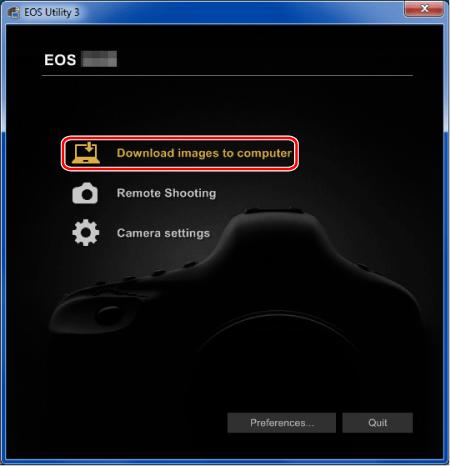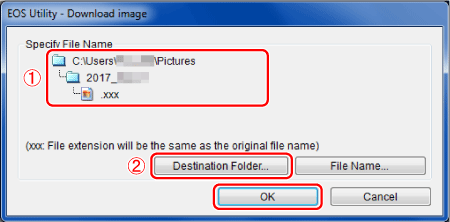Using W-E1 to Send Images to a Computer Wirelessly (EOS Utility 3.x) (EOS 7D Mark II)
16-Oct-2017
8203754100
Solution
You can connect the camera to a computer with a Wi-Fi Adapter W-E1 (sold separately) and save images from the camera to a computer remotely using EOS Utility (EOS software).
This section explains how to connect the camera directly to a computer via Wi-Fi.

REFERENCE
To connect using a Wi-Fi access point or connect manually in camera access point mode, see "Wi-Fi Adapter W-E1 Instruction Manual".
IMPORTANT
- Images cannot be recorded on the W-E1. Be sure to prepare a CF (CompactFlash) card for recording images. If a CF card is not inserted, [Unsupported card for recording] appears on the LCD monitor when you turn on the power or release the shutter.
- If the camera’s grip is covered by your hand, the wireless communication speed may decrease or the wireless communication may be terminated.
- Depending on the transmission range and connection status, image display may be delayed, images may not be displayed smoothly, or shutter release timing may be delayed.
- Note that Canon cannot be held liable for any loss or damage from erroneous wireless communication settings for using the W-E1. In addition, Canon cannot be held liable for any other loss or damage caused by use of the W-E1.
- When using wireless functions, establish appropriate security at your own risk and discretion. Canon cannot be held liable for any loss or damage caused by unauthorized access or other security breaches.
1. Check the camera’s firmware version.
Turn on the camera’s power switch. To check the firmware version, see the camera menu [  :
:  firmware ver.] and make sure that the camera’s firmware version is as follows.
firmware ver.] and make sure that the camera’s firmware version is as follows.
 :
:  firmware ver.] and make sure that the camera’s firmware version is as follows.
firmware ver.] and make sure that the camera’s firmware version is as follows.EOS 7D Mark II : Ver. 1.1.0 or later
REFERENCE
If the firmware needs to be changed, refer to the Canon Web site.
IMPORTANT
When changing the firmware, remove the W-E1 from the camera. The firmware cannot be changed with the W-E1 installed in the camera.
2. Check the environment on your computer.
To check if your computer supports connection to a camera via Wi-Fi, refer to the "Related information" section below.
3. Make sure that EOS Utility is installed on the computer.
IMPORTANT
Settings may be disabled when an older version of software is used. Install a version of EOS Utility that is compatible with this camera.
The following settings must be performed before the camera's Wi-Fi function is used.
1. Install the W-E1 in the camera.
Set the camera’s power switch to <OFF>, insert the W-E1 into the camera’s SD card slot, and a CF card into the CF card slot. For how to insert, refer to the Camera Instruction Manual.
2. Set the camera’s power switch to <ON>.
3. Press the <MENU> button to display the menu screen.

4. Press the <  > button and select the [
> button and select the [  ] tab.
] tab.
 > button and select the [
> button and select the [  ] tab.
] tab.

5. Turn the <  > dial to select the [
> dial to select the [  ] tab.
] tab.
 > dial to select the [
> dial to select the [  ] tab.
] tab.

NOTE
If the camera’s auto power off is activated while connected, the connection will be terminated. If necessary, set [Auto power off] under the [  ] tab to [Disable].
] tab to [Disable].
 ] tab to [Disable].
] tab to [Disable]. 
To continue to use EOS Utility, perform the reconnection procedure.
6. Turn the <  > dial to select [Wi-Fi function], then press <
> dial to select [Wi-Fi function], then press <  >.
>.
 > dial to select [Wi-Fi function], then press <
> dial to select [Wi-Fi function], then press <  >.
>.

NOTE
When this setting is selected for the first time, a screen to register a nickname is displayed.
When you are connecting the camera to another device wirelessly, the nickname will be displayed on the device. Be sure to set a nickname as otherwise you cannot set the wireless functions.
Select [OK], and then enter any characters between 1 to 10 characters in length.


*For instructions on entering characters, refer to "Virtual Keyboard Operation".
When you are finished, press the <MENU> button.
Turn the <  > dial to select [OK] on the confirmation dialog, and press <
> dial to select [OK] on the confirmation dialog, and press <  >.
>.
 > dial to select [OK] on the confirmation dialog, and press <
> dial to select [OK] on the confirmation dialog, and press <  >.
>.
7. The [Wi-Fi function] screen will appear.
This concludes the basic camera settings.
1. Turn the <  > dial, select [
> dial, select [  ] (Remote control (EOS Utility)), and press the <
] (Remote control (EOS Utility)), and press the <  > button.
> button.
 > dial, select [
> dial, select [  ] (Remote control (EOS Utility)), and press the <
] (Remote control (EOS Utility)), and press the <  > button.
> button.
2. Turn the <  > dial, select [Easy connection] and press the <
> dial, select [Easy connection] and press the <  > button.
> button.
 > dial, select [Easy connection] and press the <
> dial, select [Easy connection] and press the <  > button.
> button.
3. Turn the <  > dial, select [OK] and press <
> dial, select [OK] and press <  >.
>.
 > dial, select [OK] and press <
> dial, select [OK] and press <  >.
>.
4. Operate the computer and connect it to the camera.
- In the wireless settings of the computer to be used, select the SSID (network name) (
 ) displayed on the camera’s LCD monitor.
) displayed on the camera’s LCD monitor. - For the password, enter the encryption key (
 ) displayed on the camera’s LCD monitor.
) displayed on the camera’s LCD monitor.
Computer’s screen (sample)

Camera’s screen

NOTE
When connecting by selecting [Easy connection], "_Canon0A" is displayed at the end of the SSID.
5. Select [OK] and press <  >.
>.
 >.
>.
6. The following message is displayed. "******" represents the last six digits of the MAC address of the W-E1.

7. Start EOS Utility on the computer.
- For Windows 7, click the [Start] button and select [All Programs] ->[Canon Utilities] ->[EOS Utility] ->[EOS Utility].
- For Windows 8, right-click the [Start] screen, then click [All Apps] on the bottom right side of the screen. On the [Apps] screen that is displayed, click [EOS Utility].
- For Windows 8.1, click [
 ] on the bottom left side of the [Start] screen. On the [Apps] screen that is displayed, click [EOS Utility].
] on the bottom left side of the [Start] screen. On the [Apps] screen that is displayed, click [EOS Utility]. - For Windows 10, click the [Start] button, then click [All Apps] and then click [EOS Utility].
- For Mac OS X, click the [EOS Utility] icon in the Dock.
8. In EOS Utility, click [Pairing over Wi-Fi/LAN].
If a firewall-related message is displayed, select [Yes].

9. Select the camera to connect to, then click [Connect].

10. When the camera detects the computer on which you clicked [Connect] in step 9, the screen below is displayed.
- Select [OK] and press <
 >.
>.

11. The [  Wi-Fi on] screen will appear.
Wi-Fi on] screen will appear.
 Wi-Fi on] screen will appear.
Wi-Fi on] screen will appear.- To return to the menu, press the <MENU> button.

CAUTION
While connected, battery power is consumed. If you will not use the wireless communication functions for a prolonged period, terminate the connection.
NOTE
Once pairing is complete, there is no need to perform pairing from the next time on if you continue using the same camera and computer together without changing the settings.
The settings for connecting the camera to a computer are now complete.
1. The main window of EOS Utility will be displayed, so click [Download images to computer].

2. Click  [Start automatic download], or
[Start automatic download], or  [Select and download].
[Select and download].
 [Start automatic download], or
[Start automatic download], or  [Select and download].
[Select and download].
NOTE
By default, the downloaded images are saved in the [Pictures] folder. You can change the save destination for images downloaded and images to download in [Preferences].
3. When [Select and download] is selected in step 2, the viewer window appears and the images in the memory card are displayed.
In the displayed list of images, checkmark the images to download and click [Download] (here, 4 images are selected).
If you selected [Start automatic download], proceed to step 5.

NOTE
- Click [
 ] to change the thumbnail order.
] to change the thumbnail order. - For movie files, the [
 ] icon appears on the top left of the image.
] icon appears on the top left of the image. - Click [
 ] to sort the images with various conditions and choose images you want to download.
] to sort the images with various conditions and choose images you want to download.
4. The [Download image] screen appears. Click [Destination Folder] and specify the destination, then click [OK].

 Displays the save destination on the computer
Displays the save destination on the computer Specify the save destination
Specify the save destination5. The [Save File] screen appears. The images are downloaded to your computer.

6. When all images have been downloaded, click the [Quit] button to close EOS Utility.
Downloading images is now complete.
When setting a nickname for the camera, use the virtual keyboard. For instructions on entering characters, see below.
The nickname can be changed later from the [Wi-Fi function] menu.

- Changing the entry area
Press the < > button to toggle between the top and bottom entry areas.
> button to toggle between the top and bottom entry areas.
 > button to toggle between the top and bottom entry areas.
> button to toggle between the top and bottom entry areas.- Moving the cursor
Use <  > in the top area to move the cursor.
> in the top area to move the cursor.
 > in the top area to move the cursor.
> in the top area to move the cursor.- Entering text
In the bottom area, use <  > to select a character, then press <
> to select a character, then press <  > to enter it.
> to enter it.
 > to select a character, then press <
> to select a character, then press <  > to enter it.
> to enter it.You can check how many characters you have entered and how many more can be entered by referring to [*/*] on the upper right of the screen.
- Deleting a character
Press the <  > button to delete one character.
> button to delete one character.
 > button to delete one character.
> button to delete one character.- Finishing the text entry
Press the <MENU> button to confirm what you have entered and exit. If a confirmation dialog is displayed, select [OK] to exit.
- Canceling the text entry
Press the <INFO.> button to cancel text entry and exit. If a confirmation dialog is displayed, select [OK] to exit.